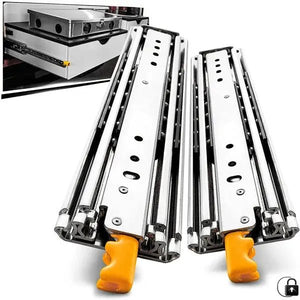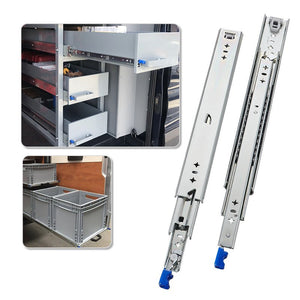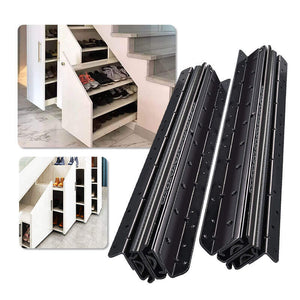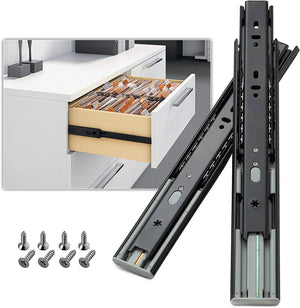I.Introduction
Older cabinets often come with drawer runners that have endured years of use. Signs of deterioration may manifest as difficulty in opening and closing drawers, visible wear on the runners, increased noise during movement, or drawers that no longer align properly. These issues not only affect the convenience of daily tasks but also pose potential risks, such as misaligned drawers causing accidents or damage.
In the subsequent sections, we will explore the signs indicating the need for drawer runner replacement, assess compatibility with existing cabinets, and provide a step-by-step guide on how to undertake this upgrade. Additionally, real-life case studies will showcase successful replacements, and we will address frequently asked questions to ensure a comprehensive understanding of this essential home improvement task.

II. Signs Your Drawer Runners Need Replacement
Drawer runners, although often underestimated, play a pivotal role in the functionality of cabinets. Over time, wear and tear can take a toll on these essential components. Here are the signs indicating that your drawer runners might be in need of replacement:
Recognizing the Telltale Signs
-
Difficult Drawer Movement: If you find it increasingly challenging to open or close your drawers smoothly, it could be a sign that the runners are worn or damaged.
-
Visible Wear and Tear: Inspect the runners for any visible signs of wear, such as scratches, dents, or deformation. These issues can impede proper drawer operation.
-
Increased Noise: Unusual or heightened noise during drawer movement is a clear indicator of potential issues with the runners. This could be due to friction or misalignment.
-
Misaligned Drawers: If your drawers no longer align correctly when closed, it suggests a problem with the runners. Misalignment can lead to uneven wear and compromised functionality.
-
Drawer Slippage: Drawers that slip or partially open on their own are indicative of worn-out or malfunctioning runners.
The Impact of Ignoring These Signs
Ignoring these signs can lead to more significant problems over time. Continued use of deteriorating drawer runners may result in:
-
Further Damage: Worn runners can cause additional damage to both the drawers and the cabinet structure, leading to costly repairs.
-
Safety Risks: Misaligned drawers pose a safety risk, as they may unexpectedly open or jam, potentially causing injury or damage to belongings.
-
Compromised Functionality: Deteriorating runners compromise the overall functionality of the cabinet, making daily tasks more cumbersome and less efficient.
In the next section, we will explore the essential tools and materials needed for a successful drawer runner replacement. Understanding these signs empowers homeowners to address issues promptly, ensuring the longevity and optimal performance of their cabinets.

III. Assessing Compatibility
Ensuring the replacement of your drawer runners is a seamless process requires a thorough assessment of compatibility. Before diving into the replacement procedure, consider the following aspects to guarantee the new runners align perfectly with your cabinet:
Understanding Drawer Types
-
Traditional Wooden Drawers:
- Measure the dimensions of your existing wooden drawers, including length, width, and height. The most important thing is to measure the installation gap of the drawer and the depth of the drawer cabinet clearly to avoid failure during installation.
- Consider the weight capacity required for items typically stored in these drawers. For example, it is recommended to use bottom-mounted heavy-duty drawer slides for drawers in the kitchen that store tableware or kitchen utensils, and light-weight drawer slides for cabinets that store stationery or books in the bedroom.
-
Metal or Plastic Drawers:
- Evaluate the type of material used in the drawer. Whether it is metal or plastic, it needs to be specifically evaluated to see if the drawer can function properly.
- Verify material compatibility of alternative slides with drawer materials. Make sure the slide rails used can be installed on the drawer without any obstruction and can be pulled out normally.
Compatibility Considerations
-
Size and Dimensions:
- Accurate measurements are crucial. Ensure the replacement runners match the exact length, width, and height specifications of your existing drawers.
- Consider any variations in size, such as those accommodating thicker or thinner drawer materials.
-
Weight Capacity:
- Evaluate the weight capacity of the new runners to ensure it aligns with the load-bearing requirements of your drawers.
- Overestimating the weight capacity is advisable to provide a safety margin for heavier items.
-
Material Compatibility:
- Verify that the material of the replacement runners complements the material of your drawers. For instance, if you have metal drawers, opt for runners designed for metal applications.
-
Installation Type:
- Determine whether your drawers require side-mount, bottom-mount, or undermount runners. Choose replacement runners that match the specific installation type.
-
Extension Type:
- Consider the extension type of the existing drawers. Whether it's a full extension, partial extension, or over-travel, select replacement runners that replicate the extension style for consistent functionality.
By understanding the compatibility nuances associated with your drawer type and cabinet structure, you pave the way for a smooth replacement process. The next section will delve into the essential tools and materials required for the replacement, ensuring you are well-prepared for the task.

IV. Steps to Replace Drawer Runners
Embarking on the journey to replace your drawer runners is a task that, when approached methodically, can bring renewed functionality to your furniture. Here's a step-by-step guide to ensure a smooth and effective replacement process:
Removal of Existing Runners
-
Empty the Drawer:Begin by removing all items from the drawer, ensuring a clear workspace.
-
Locate Mounting Screws:Identify and remove the mounting screws securing the existing runners to the drawer.
-
Detach Existing Runners:Carefully detach the old runners from both the drawer and the cabinet.
Assessing Compatibility of Replacement Runners
-
Match Dimensions:Confirm that the replacement runners align with the dimensions of the original ones.
-
Verify Installation Type:Ensure the replacement runners match the type of installation required, whether side-mount, bottom-mount, or undermount.
Installing the New Runners
-
Align and Attach:Position the replacement runners accurately and secure them in place using the provided screws.
-
Check Smooth Movement:est the drawer's movement to guarantee the new runners provide smooth and even gliding.
-
Adjust for Alignment:Make minor adjustments if needed to align the drawer perfectly.
Final Checks and Adjustments
-
Ensure Stability:Confirm that the drawer is stable and doesn't wobble after the replacement.
-
Check Closing Mechanism:Test the closing mechanism to guarantee the drawer shuts securely.
-
Reorganize Items:Once satisfied with the replacement, neatly organize the items back into the drawer.
Maintenance Tips for Longevity
-
Regular Cleaning:Keep the drawer and runners clean from debris, ensuring smooth operation.
-
Lubrication:Apply a silicone-based lubricant to the runners periodically to reduce friction.
-
Monitor Weight Limits:Adhere to weight limits to prevent excessive strain on the runners.
V. Case Studies: Successful Drawer Runner Replacements
In this section, we'll explore real-world case studies showcasing the successful replacement of drawer runners. These instances provide valuable insights into the challenges faced, the solutions implemented, and the positive outcomes achieved through upgrading drawer runners.

Case Study 1
Background: A homeowner inherited a set of antique dressers with worn-out and noisy drawer runners. Seeking a solution to preserve the vintage charm while enhancing functionality, they opted for an upgrade.
Solutions: Choosing concealed soft-close drawer runners allowed for a seamless upgrade without compromising the visual integrity of the antique dressers.
Outcomes: The upgraded drawer runners not only maintained the timeless beauty of the antique furniture but also provided a modern touch, ensuring a noise-free and effortless drawer experience.

Case Study 2
Background: A small business office faced productivity issues due to malfunctioning drawer runners in office cabinets. Constant jams and misalignments disrupted the workflow.
Solutions: Upgrading to heavy-duty, ball-bearing drawer runners with a push-to-open mechanism addressed the issues, providing a seamless and efficient storage solution.
Outcomes: The upgraded drawer runners significantly reduced downtime caused by drawer issues, leading to improved productivity and a more organized office environment.

Case Study 3
Background: A school faced persistent challenges with drawer runners in student desks and storage units. The frequent wear and tear required a reliable, long-term solution.
Solutions: Opting for heavy-duty, corrosion-resistant drawer runners with a soft-close feature ensured durability and addressed safety concerns.
Outcomes: The upgraded drawer runners not only withstood the demanding school environment but also contributed to a quieter and safer classroom setting.
VI. Conclusion
As we conclude this comprehensive guide on drawer runners, it's clear that these seemingly small components play a crucial role in the functionality and longevity of your furniture. From understanding the signs that indicate the need for replacement to mastering the steps for a successful upgrade, we've covered a spectrum of topics to empower you as a user.
As you embark on your journey to explore and choose the perfect drawer runners, consider AOLISHENFG as your trusted partner. Our range includes side-mount, bottom-mount, rebound, buffer, and stainless steel drawer runners, catering to diverse needs. Explore the possibilities, enhance your furniture, and elevate your overall interior design with AOLISHENFG.
Should you have any questions or require expert guidance on selecting, replacing, or upgrading drawer runners, our team at AOLISHENFG is here to assist. We're committed to providing quality products and ensuring your furniture stands the test of time.
AOLISHENFG is your partner in this journey, offering not just drawer runners but a commitment to excellence in every piece of furniture you own.





